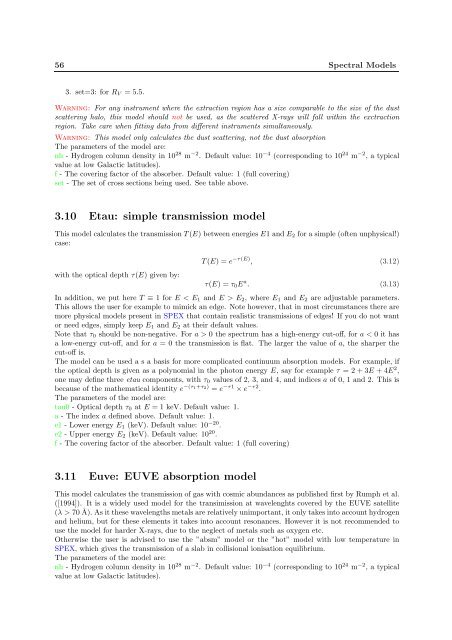SPEX User's Manual - SRON
SPEX User's Manual - SRON
SPEX User's Manual - SRON
Create successful ePaper yourself
Turn your PDF publications into a flip-book with our unique Google optimized e-Paper software.
56 Spectral Models<br />
3. set=3: for R V = 5.5.<br />
Warning: For any instrument where the extraction region has a size comparable to the size of the dust<br />
scattering halo, this model should not be used, as the scattered X-rays will fall within the exctraction<br />
region. Take care when fitting data from different instruments simultaneously.<br />
Warning: This model only calculates the dust scattering, not the dust absorption<br />
The parameters of the model are:<br />
nh - Hydrogen column density in 10 28 m −2 . Default value: 10 −4 (corresponding to 10 24 m −2 , a typical<br />
value at low Galactic latitudes).<br />
f - The covering factor of the absorber. Default value: 1 (full covering)<br />
set - The set of cross sections being used. See table above.<br />
3.10 Etau: simple transmission model<br />
This model calculates the transmission T(E) between energies E1 and E 2 for a simple (often unphysical!)<br />
case:<br />
T(E) = e −τ(E) , (3.12)<br />
with the optical depth τ(E) given by:<br />
τ(E) = τ 0 E a . (3.13)<br />
In addition, we put here T ≡ 1 for E < E 1 and E > E 2 , where E 1 and E 2 are adjustable parameters.<br />
This allows the user for example to mimick an edge. Note however, that in most circumstances there are<br />
more physical models present in <strong>SPEX</strong> that contain realistic transmissions of edges! If you do not want<br />
or need edges, simply keep E 1 and E 2 at their default values.<br />
Note that τ 0 should be non-negative. For a > 0 the spectrum has a high-energy cut-off, for a < 0 it has<br />
a low-energy cut-off, and for a = 0 the transmission is flat. The larger the value of a, the sharper the<br />
cut-off is.<br />
The model can be used a s a basis for more complicated continuum absorption models. For example, if<br />
the optical depth is given as a polynomial in the photon energy E, say for example τ = 2 + 3E + 4E 2 ,<br />
one may define three etau components, with τ 0 values of 2, 3, and 4, and indices a of 0, 1 and 2. This is<br />
because of the mathematical identity e −(τ1+τ2) = e −τ1 × e −τ2 .<br />
The parameters of the model are:<br />
tau0 - Optical depth τ 0 at E = 1 keV. Default value: 1.<br />
a - The index a defined above. Default value: 1.<br />
e1 - Lower energy E 1 (keV). Default value: 10 −20 .<br />
e2 - Upper energy E 2 (keV). Default value: 10 20 .<br />
f - The covering factor of the absorber. Default value: 1 (full covering)<br />
3.11 Euve: EUVE absorption model<br />
This model calculates the transmission of gas with cosmic abundances as published first by Rumph et al.<br />
([1994]). It is a widely used model for the transimission at wavelenghts covered by the EUVE satellite<br />
(λ > 70 Å). As it these wavelengths metals are relatively unimportant, it only takes into account hydrogen<br />
and helium, but for these elements it takes into account resonances. However it is not recommended to<br />
use the model for harder X-rays, due to the neglect of metals such as oxygen etc.<br />
Otherwise the user is advised to use the ”absm” model or the ”hot” model with low temperature in<br />
<strong>SPEX</strong>, which gives the transmission of a slab in collisional ionisation equilibrium.<br />
The parameters of the model are:<br />
nh - Hydrogen column density in 10 28 m −2 . Default value: 10 −4 (corresponding to 10 24 m −2 , a typical<br />
value at low Galactic latitudes).

















